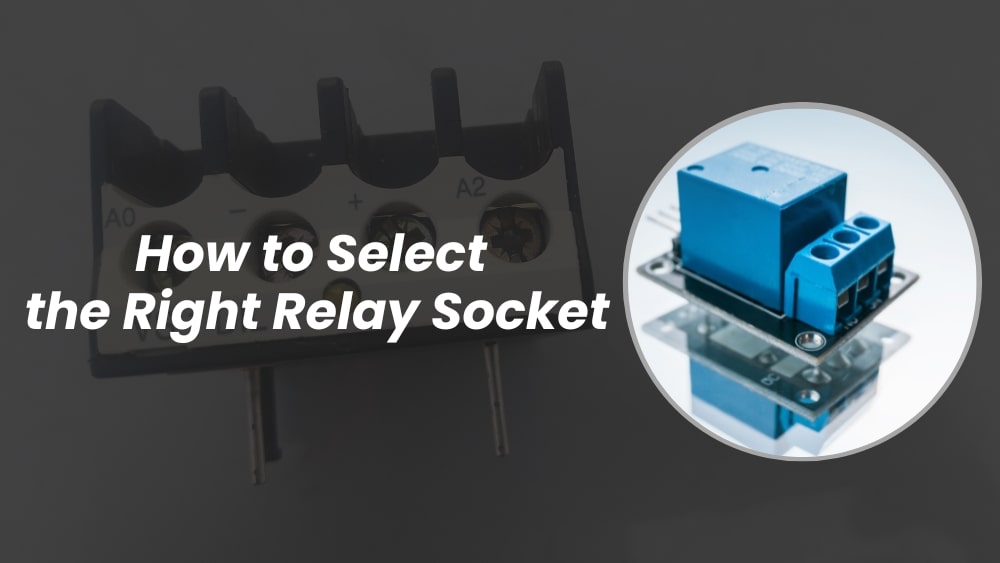Choosing the right relay socket is more important than it might seem. The right socket ensures reliable connections, protects your system, and makes maintenance easier. Whether for industrial use or everyday electronics, understanding your relay’s requirements is key to making the right choice.
With many types of relay sockets available, such as plug-in, PCB, and DIN rail-mounted, it’s essential to consider factors beyond just size—like electrical ratings, mechanical strength, and environmental resistance. This guide will help you navigate those details for a confident purchase.
By paying attention to these key points, you can avoid common mistakes and improve the performance and longevity of your equipment. Let’s explore what you need to know to pick the best relay socket for your application.
What is a Relay Socket?
A relay socket is a device designed to securely hold a relay and provide easy electrical connections, simplifying relay replacement and maintenance without the need to rewire. Relay sockets come in various types, such as plug-in, PCB-mounted, and DIN rail-mounted, tailored for different installation methods and application requirements.
Relay sockets are widely used in industrial control panels, HVAC systems, automotive electronics, telecommunication equipment, and home appliances. Understanding the different types of relay sockets is key to selecting the right product.
Key Factors to Consider When Choosing a Relay Socket
| Factor | Description |
|---|---|
| Compatibility | Ensure socket matches relay type, size, and pin configuration for secure fit and connection. |
| Electrical Specifications | Supports required voltage and current ratings to prevent failure and maintain reliability. |
| Mechanical Features | Durability, ease of installation, and secure holding of relay; may include locking or vibration resistance. |
| Environmental Conditions | Ability to withstand temperature, humidity, dust, and chemical exposure with proper protection ratings. |
| Safety Standards & Certifications | Compliance with standards like UL, CE, RoHS ensures safety, quality, and regulatory adherence. |
1. Compatibility with Relay Type and Size
When choosing a relay socket, it is essential to ensure compatibility with the relay’s type and size. The socket must match the relay’s pin configuration, dimensions, and mounting style to guarantee a secure fit and proper electrical contact. Using an incompatible socket may result in poor connections or damage to the device.
2. Electrical Specifications
The relay socket should meet the electrical specifications required by the application, including the maximum load current and the control voltage for the relay coil. Ensuring the socket can handle these electrical parameters helps maintain reliable operation and prevents overheating or failure.
3. Mechanical Features
Mechanical features are also important. Consider the durability of the socket, ease of installation, and its ability to hold the relay firmly during operation. Some sockets come with locking mechanisms or vibration resistance, which are suitable for environments with movement or shocks.
4. Environmental Conditions
Environmental conditions must be taken into account. Depending on the application, the socket may need to withstand extreme temperatures, humidity, dust, or chemical exposure. Choosing a socket with appropriate protection ratings, such as IP ratings, ensures long-term stability and safety in specific environments.
5. Safety Standards and Certifications
Safety standards and certifications are vital for compliance and reliability. Selecting relay sockets that have certifications such as UL, CE, or RoHS means the product has undergone rigorous testing for safety, quality, and environmental impact. This protects equipment and personnel and ensures regulatory compliance.
Additional Features and Considerations
Some relay sockets come with extra features to improve usability and system reliability:
Indicator Lights: LED indicators provide real-time visual feedback on the relay coil’s status (energized or de-energized), simplifying troubleshooting and reducing downtime. Some advanced models may include dual-color LEDs to distinguish between normal operation and fault conditions.
Test Buttons: Allow manual activation of the relay for testing without powering the coil, enabling quick verification of downstream circuit functionality. This feature is particularly useful during maintenance or commissioning.
Terminal Types: Choose between screw terminals (secure and adjustable), spring clamp terminals (tool-free, vibration-resistant), or solder terminals (permanent, space-saving) based on your wiring preferences, environmental conditions, and maintenance requirements.
Ease of Installation: Quick-connect or plug-in sockets speed up assembly and replacement, minimizing downtime during repairs or upgrades. Some sockets also feature finger-safe designs or color-coded terminals for faster wiring.
Cost vs. Quality: While cheaper options might save upfront money, investing in high-quality relay sockets reduces maintenance costs, prevents connection issues (e.g., loose terminals), and minimizes system failures. Premium sockets often include better insulation, higher durability, and compliance with industry standards (e.g., UL, CE).
Additional Considerations:
Mounting Options: DIN-rail, panel-mount, or PCB-mount sockets cater to different installation environments.
Current/Voltage Ratings: Ensure the socket matches the relay’s specifications to avoid overheating or arcing.
Environmental Protection: Look for sockets with IP ratings (e.g., IP40, IP67) if used in harsh conditions (dust, moisture, or temperature extremes).
How to Identify Quality Relay Sockets
1. Material and Build Quality
High-quality relay sockets are usually made of heat-resistant and mechanically strong materials, such as flame-retardant plastics or ceramics. The contacts are generally gold- or silver-plated to ensure low resistance and corrosion resistance.
2. Compatibility and Standards
Ensure that the socket is compatible with the relay model you intend to use. Check whether it complies with industry standards such as UL, IEC, and RoHS, which guarantee product safety and environmental compliance.
3. Electrical Ratings
Confirm that the socket’s voltage and current ratings meet or exceed the relay’s requirements. Also pay attention to insulation resistance and dielectric strength to prevent electrical faults.
4. Mechanical Features
Quality sockets should offer convenient and secure mounting options, such as DIN rail mounting, PCB mounting, or panel mounting. Locking mechanisms or clip designs ensure that the relay will not loosen due to vibration.
5. Wiring and Terminals
The type of terminals (screw, spring clamp, solder, or plug-in) should suit wiring needs and ensure secure connections. Clear labeling makes identification and wiring easier.
6. Thermal Management
Good socket designs effectively dissipate heat by using suitable materials or structures (such as ventilation slots) to reduce temperature and extend service life.
7. Manufacturer Reputation and Support
Choose brands with a good reputation, as they usually provide detailed datasheets, certification documents, and technical support. Also, accessory and spare parts supply tends to be more reliable.
Common Mistakes to Avoid When Purchasing Relay Sockets
| No. | Mistake | Key Point |
|---|---|---|
| 1 | Ignoring Compatibility Issues | Ensure relay type, size, and pin configuration match |
| 2 | Overlooking Electrical Ratings | Check voltage and current ratings for safety and reliability |
| 3 | Neglecting Mechanical Durability | Consider strength and vibration resistance |
| 4 | Ignoring Environmental Conditions | Account for temperature, moisture, dust, and chemicals |
| 5 | Disregarding Safety Certifications | Verify UL, CE, RoHS or other relevant certifications |
| 6 | Underestimating Installation Ease | Evaluate ease of installation and future maintenance |
1. Ignoring Compatibility Issues
Selecting a relay socket that does not match the relay’s type, size, or pin configuration can lead to poor connections, unreliable operation, or damage to the relay and socket.
2. Overlooking Electrical Ratings
Failing to verify if the socket supports the required voltage and current ratings can cause overheating, electrical failures, or safety hazards.
3. Neglecting Mechanical Durability
Choosing sockets without considering mechanical strength or vibration resistance may result in loose connections, especially in environments with shocks or movement, causing system instability.
4. Ignoring Environmental Conditions
Buying relay sockets without accounting for temperature extremes, moisture, dust, or chemical exposure can drastically reduce the socket’s lifespan and reliability.
5. Disregarding Safety Certifications
Skipping verification of safety standards and certifications like UL, CE, or RoHS may lead to using substandard or non-compliant components, risking equipment damage or regulatory problems.
6. Underestimating Installation and Maintenance Ease
Not considering how easy it is to install or replace the relay socket can lead to longer downtime and higher labor costs, especially in complex systems requiring frequent maintenance.
Step-by-Step Purchase Guide
Begin by thoroughly assessing your application requirements. This involves understanding the specific relay type you need, along with the voltage and current ratings it must handle, as well as the environmental conditions where the relay socket will be used. Having clear requirements helps narrow down suitable options.
Next, research relay sockets that are compatible with your relay model and match your preferred mounting style, whether it’s PCB, DIN rail, or plug-in types. Compatibility at this stage is crucial to avoid installation issues later.
After identifying potential options, verify the detailed specifications and certifications of the relay sockets. Make sure they meet all necessary electrical, mechanical, and safety standards to ensure reliable and safe operation.
Choose a reputable supplier or authorized distributor to purchase from, as this ensures product authenticity and access to technical support or warranty services.
Finally, before deploying the relay sockets across your system, conduct tests under actual operating conditions. This step helps validate the socket’s performance and reliability, reducing the risk of unexpected failures after installation.
FAQs
Q1: How to confirm if a relay socket is compatible with my relay when purchasing?
Ensure the socket supports the relay’s pin configuration, coil voltage, and rated current. Full compatibility prevents poor contact or damage.
Q2: What environmental factors should be considered when buying a relay socket?
Consider temperature range, dust and water protection level (IP rating), and chemical resistance to ensure the socket works properly on-site.
Q3: How do I know if a relay socket matches my relay?
Check the relay’s pin layout, coil voltage, and rated current. The socket must meet these specs for proper installation and operation.
Q4: How important are certifications when purchasing relay sockets?
Very important. Certifications like UL, CE, and RoHS ensure the socket meets safety and quality standards, protecting your system and users.
Conclusion
In summary, selecting a suitable relay socket means matching it carefully to your relay’s specs and the operating environment. Checking electrical and mechanical requirements, certifications, and testing beforehand will help you avoid costly problems later.
Don’t compromise on quality or overlook important features just to save money upfront. A good relay socket is the foundation for reliable system operation and peace of mind.
For trusted, high-quality relay sockets tailored to diverse needs, CDGKZ offers a reliable range with expert support. Choose CDGKZ for durable, professional solutions that keep your projects running smoothly.





